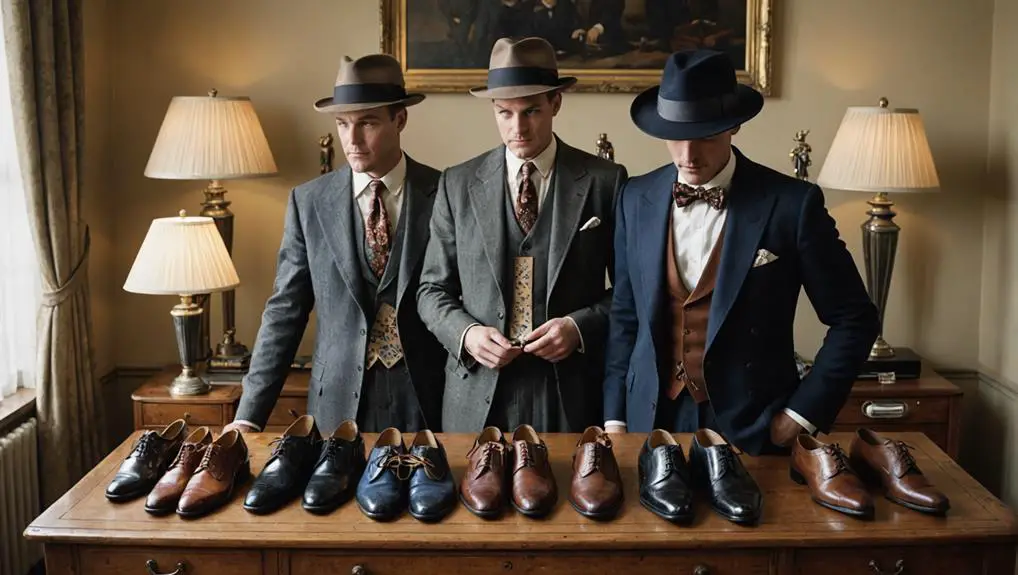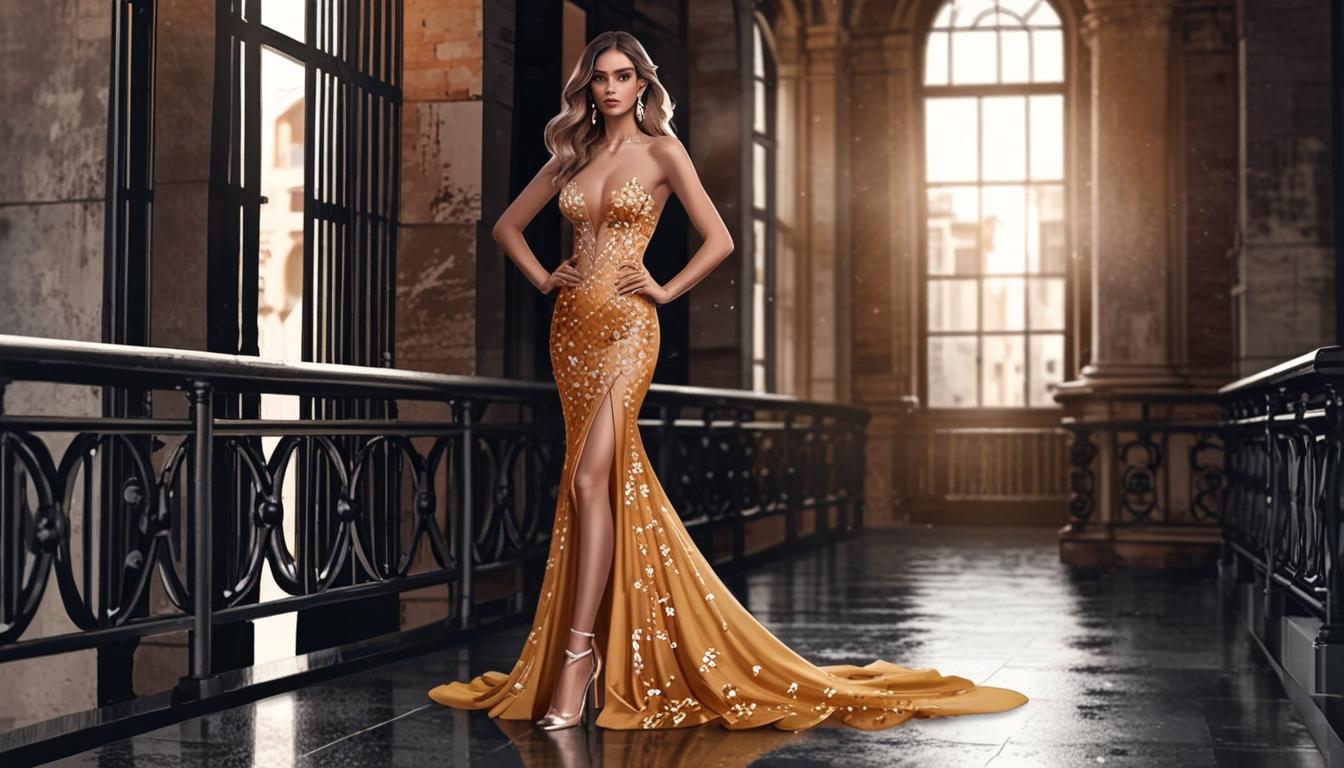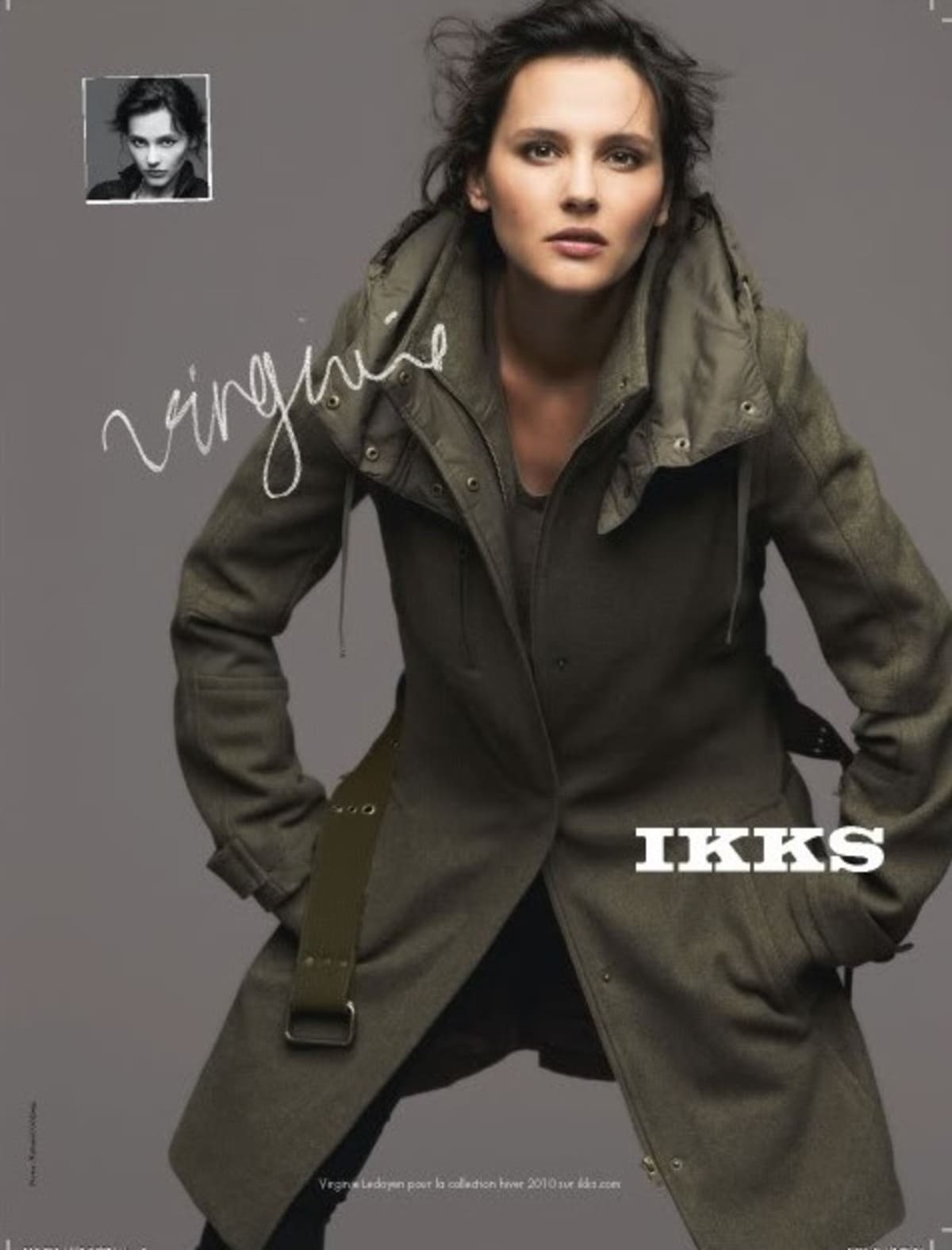Men's ties and bowties in the 1930s became essential fashion statements, reflecting personal style amidst cultural shifts. You'd see ties made from silk, rayon, and durable wool, often adorned with bold Art Deco patterns. Neckties ranged from 44 to 58 inches, showcasing vibrant colors and unique motifs. Bowties, softer in construction, offered adjustable fits and playful designs that allowed for personal expression. Recognized brands like Wembley and Mattei Bros defined quality during this time, and pricing varied widely based on materials and artistry. The allure of these accessories captures a rich history of fashion evolution, encouraging further exploration into their significance.
Overview of 1930s Ties
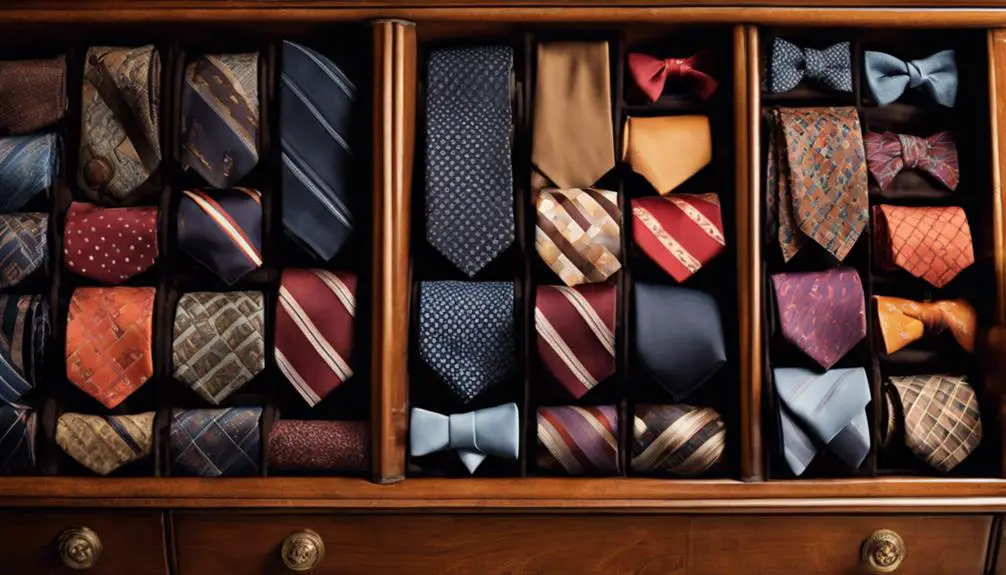
In the 1930s, ties underwent a remarkable transformation, becoming an essential accessory that reflected both personal style and cultural trends. Vintage neckties from this era showcased a newfound appreciation for high-quality materials like silk, rayon, and brocade. The vibrant colors and intricate patterns drew heavily from Art Deco aesthetics, featuring geometric designs that captivated men's fashion.
Typically measuring between 44.5 inches and 58 inches, these ties offered a variety of styles, including bold checkered patterns and hand-painted motifs celebrating popular themes like Hawaiian dancers and pinup girls. The craftsmanship of 1930s ties is particularly exceptional, with features such as untipped designs and diverse fabric textures enhancing their authenticity.
As a collector, you'll find that prices for these vintage neckties range from $15.00 to $79.50, with some rare pieces fetching even higher amounts. The increasing demand for 1930s ties among fashion enthusiasts highlights a broader interest in unique accessories that reflect the cultural movements of the time, particularly jazz and swing. Embracing these neckties not only elevates your wardrobe but also connects you to a rich, stylish history.
Characteristics of Bow Ties
Elegance defines the characteristics of 1930s bow ties, which became a popular accessory that allowed men to express their individuality. These vintage ties showcased unique patterns and vibrant colors, capturing the era's fashion sensibilities. The materials used, including luxurious silk, rayon, and wool, contributed to a refined appearance and feel. Understanding the historical context of these accessories is essential for recognizing genuine vintage pieces, as vintage clothing encompasses items from previous decades.
You'll notice some key features that set 1930s bow ties apart:
- Thinner and softer construction: This design choice created a more relaxed and floppy silhouette, deviating from the stiffer neckties of previous decades.
- Self-tie varieties: Many bow ties from this time were self-tied, allowing you to adjust the fit for comfort and style, while pre-tied options started gaining traction later.
- Distinctive motifs: Hand-painted themes and bold shapes adorned these accessories, appealing to collectors and those who appreciated unique designs.
- Diverse patterns: Expect to see paisleys and geometric designs, reflecting the playful aesthetics of the era.
As you explore the world of 1930s bow ties, you'll find a rich tapestry of style, craftsmanship, and individual expression that truly defined men's fashion during that time.
Popular Styles and Patterns
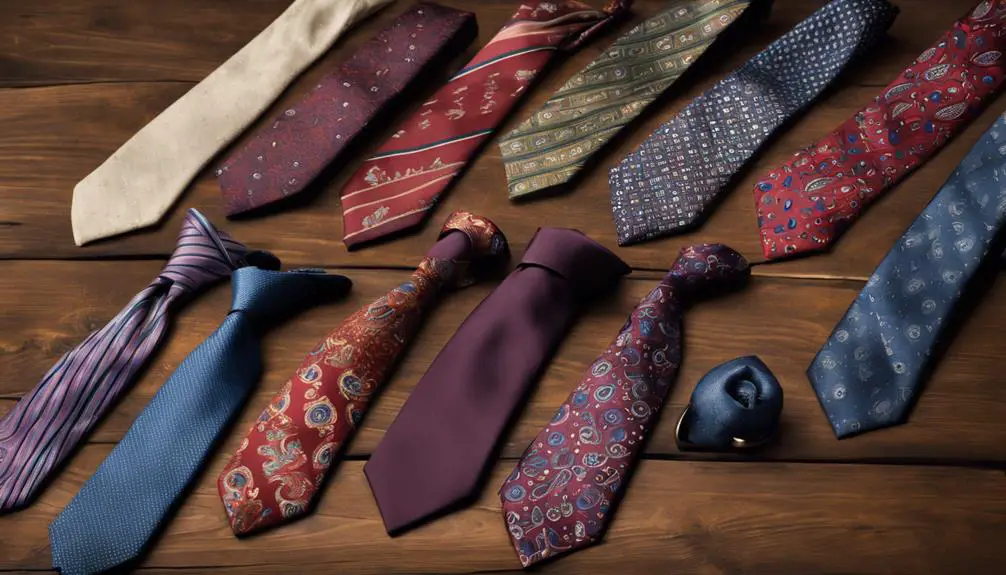
Throughout the 1930s, men's ties and bow ties evolved into vibrant expressions of style, showcasing a dynamic range of patterns and designs. Neckties often featured bold geometric shapes and Art Deco influences, while whimsical motifs like flames and paisleys captured the imagination. Hand-painted designs, including themes of Hawaiian dancers and pinup girls, became particularly popular, reflecting the era's cultural trends and artistic movements.
Here's a glimpse into the popular styles and patterns of the time:
| Style/Pattern | Description |
|---|---|
| Vintage Floral Mens Silk | Delicate floral prints, often in soft colors, added elegance. |
| Geometric Designs | Bold patterns with sharp angles and lines, often contrasting colors. |
| Paisley | Classic teardrop shapes, often in rich, vibrant hues. |
| Flames | Whimsical motifs that created a sense of movement and excitement. |
| Hand-Painted | Unique, often one-of-a-kind designs that showcased artisan skill. |
These styles not only highlighted the craftsmanship of the time but also emphasized the importance of personal expression in men's fashion. Whether you opted for a silk tie or a bow tie, the patterns of the 1930s offered something for every taste.
Materials Used in Ties
Emphasizing luxury and craftsmanship, the materials used in 1930s ties played an essential role in defining men's fashion of the decade. The rich textures and vibrant colors of various fabrics contributed to the elegance and style that characterized neckties and bow ties during this time.
- Silk: This luxurious fabric was favored for its sheen and smooth texture, making it ideal for formal occasions.
- Rayon: As an affordable alternative to silk, rayon offered a similar aesthetic, allowing more men to access stylish neckties.
- Wool: Often used for colder weather, wool provided warmth and durability, ensuring that ties remained functional without sacrificing style.
- Brocade: Known for its intricate patterns woven into the fabric, brocade ties were typically reserved for formal events, showcasing the era's dedication to craftsmanship.
These materials not only reflected the quality of the ties but also the social status of the wearer. By selecting the right fabric, men of the 1930s expressed their individuality and sophistication, solidifying ties as essential accessories in their wardrobes.
Notable Brands of the Era
The 1930s saw a surge of creativity in men's fashion, particularly in the domain of ties, with notable brands setting the standard for quality and style. Wembley, Mattei Bros, and Artcraft emerged as leaders in the production of exceptional neckties, each offering distinctive craftsmanship that catered to the tastes of fashionable men.
Wembley ties gained popularity for their innovative patterns and materials, showcasing the era's artistic flair. Their designs often reflected the bold trends of the time, making them a go-to choice for those looking to elevate their outfits. Mattei Bros took luxury to another level, specializing in silk ties adorned with striking geometric and Art Deco patterns, synonymous with 1930s fashion.
Artcraft ties carved a niche with unique motifs and high-quality fabrics, appealing to men who appreciated both aesthetics and craftsmanship. Today, vintage ties from these brands, such as the FashionCraft Necktie Silk, are highly sought after by collectors. The original labels and detailed craftsmanship of these ties considerably enhance their value and appeal, making them timeless pieces in the world of men's accessories.
Pricing Trends for Vintage Ties
Maneuvering through the vintage tie market reveals a fascinating landscape of pricing trends that reflect both the era's charm and collectors' desires. Prices for 1930s vintage ties typically range from $4.00 to $149.99, with the average cost hovering around $19.00. This indicates a robust demand for authentic silk neckties, particularly those with standout features such as hand-painted designs. Understanding the significance of vintage clothing labels can further enhance the appreciation for these ties, as they often provide insights into the garment's provenance and value vintage tag insights.
When you explore this market, consider the following pricing factors:
- Condition: Ties in excellent condition are more desirable.
- Rarity: Limited editions, like the Necktie Mens Vintage Jack, can fetch higher prices.
- Cultural significance: Certain designs may attract collectors due to their historical context.
- Artistry: Silk Tie Hand Painted options often command a premium.
While many affordable options exist, with plenty of VTG Mens Silk Tie selections under $10, high-end pieces, especially from brands like Mens Vintage Jack Henry, can soar up to $149.99. This fluctuation in pricing not only reflects the quality and craftsmanship of these vintage ties but also the evolving tastes of modern collectors.
Collecting 1930s Men's Accessories
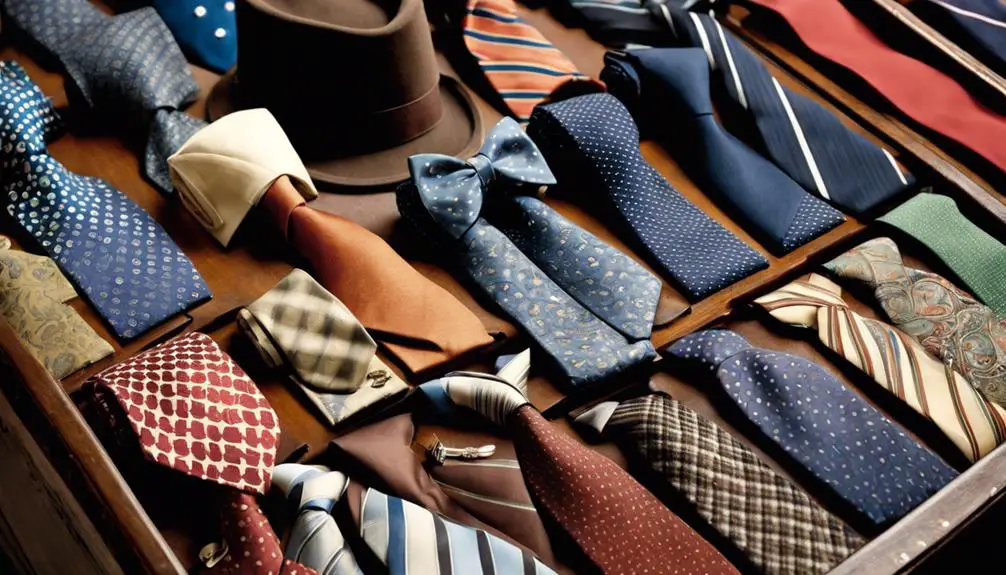
Delving into the world of collecting 1930s men's accessories reveals a vibrant tapestry of fashion that reflects the boldness and creativity of the era. As you explore this niche, you'll find that ties, especially, stand out due to their unique patterns and high-quality materials. Authentic vintage ties from this decade, including the sought-after Vintage Jack Henry Tie, showcase intricate designs that collectors crave.
Silk tie VTG mens pieces often feature geometric motifs and hand-painted themes, making them particularly desirable. The diversity of these neckties, with some evolving into 1940s necktie styles, adds depth to any collection. Prices for genuine 1930s ties can range from a modest $4.00 to an impressive $149.99, depending on rarity and condition, with the average hovering around $19.00.
The increasing popularity of themed events and vintage fashion has further fueled interest in these accessories. Recognized brands like Wembley and Mattei Bros enhance the value of your collection, as ties from reputable manufacturers are often seen as more prestigious. In this exciting world, each piece tells a story, inviting you to become part of a rich fashion history.
Impact of Cultural Movements
Often, cultural movements substantially shape fashion trends, and the 1930s is a prime example of this phenomenon. The rise of jazz and swing music infused men's ties and bowties with bold patterns and vibrant colors, mirroring the energetic spirit of the era. As you explore this decade, you'll notice how various influences manifested in unique neck tie designs.
- The Great Depression led to a preference for affordable yet stylish options, creating a demand for distinctive vintage ties.
- Art Deco's geometric motifs inspired printed foulards that showcased modernity and artistic aspirations.
- Hand-painted ties featuring themes like Hawaiian dancers and pinup girls emerged, reflecting the cultural fascination with leisure and escapism.
- Hollywood glamor played a pivotal role, making ties essential accessories for both formal and casual gatherings.
In this context, a floral mens silk tie or a silk tie from Fargo, CA, not only served as a fashion statement but also as a means of personal expression. This blend of affordability, artistic influence, and Hollywood allure profoundly shaped the neck tie landscape, leaving a lasting legacy that continues to inspire today.
Frequently Asked Questions
Were Bow Ties Popular in the 1930s?
Yes, bow ties were incredibly popular during that time. They became a fashionable choice for both formal and casual occasions, showcasing vibrant colors and unique designs that reflected contemporary artistic movements, enhancing men's overall style.
How Wide Were Ties in the 1930s?
Ties in the 1930s typically ranged from 2.5 to 4 inches in width, with 3 inches being common. This trend reflected the era's bold fashion, emphasizing statement accessories and geometric patterns that defined the decade's style.
When Did Men Start Wearing Bow Ties?
Men started wearing bow ties in the mid-1800s, but their popularity soared in the 1920s. By the 1930s, you'd notice them as essential accessories for formal attire, reflecting sophistication and a keen sense of style.
Did Men Wear Bowties in the 1920s?
Yes, you'll find men wore bow ties extensively in the 1920s. They embraced bold patterns and luxurious materials, reflecting the era's fashion trends. Bow ties became a symbol of sophistication, especially during formal occasions.
